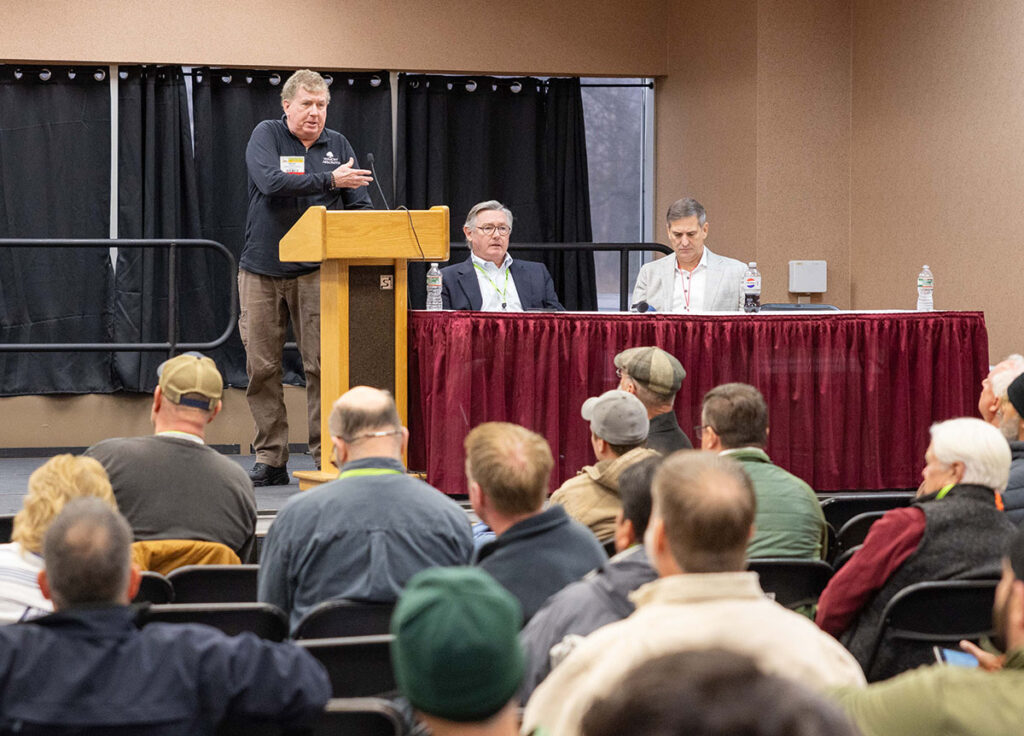Sage Advice: Overcoming Labor Obstacles
Former TCIA CEO Mark Garvin reflects on his career of political activism and business management in the tree care industry
Este es nuestro intento de convertir las historias en audio español usando Inteligencia Artificial. Aún así le recomendamos que reconfirme ciertas palabras clave y temas. ArborTIMES no garantiza ni se responsabiliza de la conversión del inglés al español de los relatos.
.

Mark Garvin came into the tree care industry sort of sideways, as he explains it. He had been an editor for a magazine in New Hampshire that ended up folding and he found himself on the hunt for a new job.

As fate had it, he saw an ad for an editor for a tree care magazine. Even though he admittedly knew nothing about the tree care industry, he did know how to fix grammar, write well, and use desktop publishing software, so he took a shot and applied.
Not only did he get hired, but he remained the editor of TCI Magazine, the official publication of the Tree Care Industry Association (TCIA), for 12 years. He eventually took over more and more responsibilities for membership, marketing, and communications. When the current CEO left, the association’s board offered Garvin the job of president and CEO, which he assumed for nine years.
When asked which role he preferred, Garvin shared that while he enjoyed his editorial position, it’s good to change and add things to your career to avoid stagnation. Moreover, he enjoyed the opportunity to look at the tree care industry from a new perspective as president. He remarked how rewarding it had been to help tree care companies grow and become more professional and profitable, which is the mission of the TCIA.
“Every company, in a way, is a family,” Garvin explains. “So, to the extent that you can make them safer and more profitable, they can offer higher wages and better benefits. It’s very rewarding to help those companies prosper.”
The Issues Haven’t Changed
Throughout his time as editor and president, Garvin has observed that the major concerns of the industry haven’t changed – namely, unethical business practices, safety concerns, and employee shortages.
First and foremost for Garvin though, is elevating the reputation of the industry so that its workers get the recognition and conditions they deserve.
“Elevating the profession itself was an issue in 1950, and it’s an issue today,” he shares. “Throw in government regulations, or inappropriate regulations, and the issues are remarkably similar, decade after decade.”
Political Advocate
Although he’s never owned a tree care company nor been in the field himself, Garvin has become a tree care advocate and has gone to the mat in Washington, D.C., to better the entire industry. The two political issues he has worked on are Occupational Safety and Health Administration (OSHA) regulations and contracting foreign tree care laborers.
OSHA wrote a standard to cover logging. And once that was in place, it was decided that the tree care industry was synonymous with loggers and should be covered by the logging standard, which is completely inappropriate, Garvin says.
“The methods we use, the equipment we use, and how we go about work are not the same as logging,” he adds.
Despite asking OSHA for a tree care standard (and to stop citing the industry under the logging standard), tree care has been waiting for its own standard for more than 25 years now. There have been times when OSHA has agreed to write a tree care standard, however, it has yet to come to fruition.

The other issue is foreign labor and getting legal workers by using H-2B visas for temporary non-agricultural workers, along with other available visas. “Unfortunately, too many companies in our industry use illegal workers,” Garvin says.
The H-2B visas are seasonal, although you can bring workers back year after year for nine months at a time. Since workers from other countries have no place to live in the U.S., it makes sense for the tree care company hiring them to provide housing if they want them to prosper and return repeatedly.
“Many of our companies have purchased a house and put people up, or purchased apartments or condos,” Garvin explains.
As it stands now, it takes a fair amount of time, paperwork, and funding to secure foreign workers. For companies that have a shortage of these resources, recruiting locally and training individuals new to the industry from the ground up is their best option.
Stiff Competition
When it comes to recruiting teenagers into the workforce, competition can be fierce. After all, the tree care industry is much more labor-intensive than the typical first-time job.
However, the benefit of training younger workers can be pivotal for the tree care industry. With fast-food restaurant wages rising in California upwards of $20 per hour, a tree care company has to offer more – benefits, advancements, and potential for growth in the company.
“You need to make it attractive for those people to come in the door,” says Garvin.

How to Get Started?
While there’s not one path to enter the tree care profession, an apprenticeship is a great option for a high schooler who wants to go right to work after graduation, explains Garvin. However, there aren’t many apprenticeships available. Only the top businesses offer to fund this opportunity.
Some colleges offer robust urban forestry and arboriculture programs, which is another option, albeit a longer one, Garvin says. You could also work during the summers at some of the larger companies, namely Davey, Bartlett, or SavATree, to get your start in tree care.
Conversely, Garvin warns not to go straight from high school to starting your own tree care company. It’s best to learn the ropes at an established and well-run company before venturing off on your own.
Of all the projects and roles that Garvin has been involved in, one rises above the others. After receiving a mandate from TCIA’s board of directors, Garvin raised $2 million from the tree care industry for the Arborist Safety Training Institute, a program that offers free safety training for tree care employees each year.
Training Promotes Safety
Professional qualifications, such as the International Society of Arboriculture (ISA) Certification, Board Certified Master Arborist program, and TCIA’s Certified Treecare Safety Professional credential, represent a significant achievement in the field.
These certifications, along with the training provided by TCIA’s Tree Care Academy, help produce not only more knowledgeable employees but safer employees, explains Garvin. And oftentimes, companies will increase wages as their employees get these credentials.
Over the years, Garvin has seen increased mechanization in the industry. An increasing number of businesses are opting to purchase or lease large equipment, such as grapple saw trucks and mini lifts, which take the place of several workers and climbers.
Working safer and more efficiently means working smarter, not harder.
“With the shortage of skilled labor, mechanization just makes sense,” he says.
“You don’t want climbers accessing a dead tree,” notes Garvin. “Twenty-five years ago, a crane was a rare thing in this industry. Now it isn’t.”
Retirement Options
Not long ago, owners of tree care companies had limited retirement choices. Do you pass the business on to your children? Do you try to sell it to your local competition? Do you sell to one of the large companies that may or may not be interested? Do you sell the real estate and all the equipment? Now tree care business owners have more options. In recent years, there has been interest in the tree care industry from buyers and outside partners.

But how do you make your business attractive to these buyers? The factors that determine the value of a company are varied. Among the top criteria are professionalism, safety, profitability, and reputation.
Acquisition or partnering companies are also looking to see if your business is accredited. Are you a member of TCIA? What credentials do your employees have? Are they certified by ISA. Do you have a CTSP (or two) on board? If two-thirds of employees were hired six months ago or less, buyers will want to dig in and find out why.
What’s the leadership structure of your company? Is the owner also the operations manager, or is there a second tier of management? What’s the owner’s desired involvement moving forward? What types of jobs does your company primarily do? What percentage is pruning, plant health care, or landscaping? All of these questions will determine if your company is a viable fit for engaging with a private equity partner.
Garvin has also sought to elevate the tree care industry through his various roles and continues to do so in his latest venture with Tree Guardians, a company that is building a diversified residential and commercial services platform. Tree Guardians partners with company owners focused on tree and plant healthcare, pruning, removals, fertilization and risk protection.


